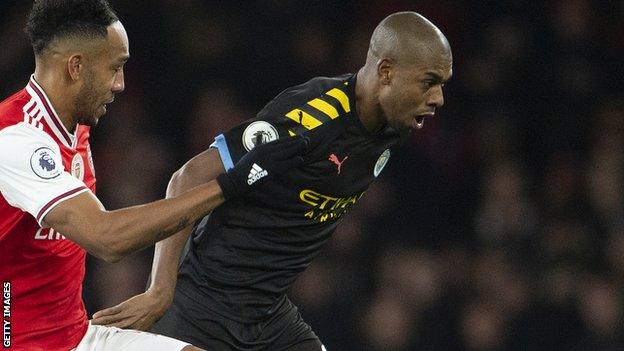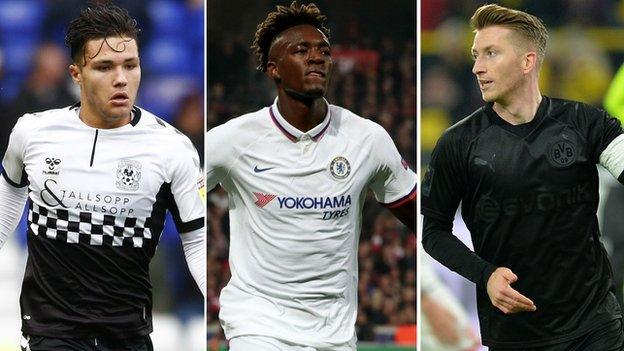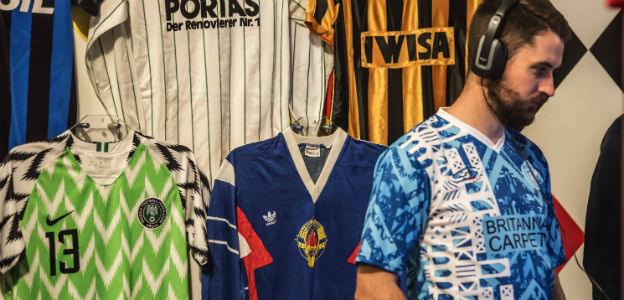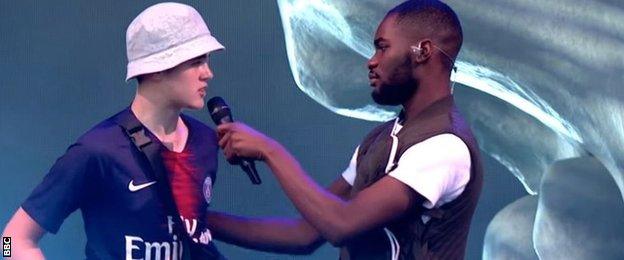Football shirts: How they got ultra local and hyper cool
- Published

The yellow and black stripes down the sleeve of Manchester City's away shirt is based on the Hacienda colour scheme
An ambitious, flagship project that brought Manchester moments of ecstasy thanks, in part, to its owners' lavish spending.
That parallel did not make the press release.
Instead when Manchester City and Puma launched this season's away shirt, inspired by the Hacienda - the fabled Factory Records-owned nightclub at the epicentre of the 1980s and 1990s "Madchester" scene - both the sports brand and the Premier League superpower kept it simple.
"The black and yellow stripes were something we saw a lot around the city," said Puma's Josele Angulo.
"For us, it was really important to highlight the story of the city... to find a connection that makes sense.
"We realised the Hacienda was something that was really representative."
City are not alone in blindsiding fans with unexpected but familiar looks.
The trend to incorporate local motifs in kits can be seen throughout English football's pyramid and beyond.
The Mod culture that thrived in West London in the 1960s is behind Chelsea's polo-shirt-style away look this season.

Coventry, Chelsea and Dortmund have all released shirts this season with local culture central to their design
The unique ska-fusion music genre 2 Tone, which sprung from Coventry 40 years ago, is the inspiration for the club's wildly successful third shirt.
Middlesbrough's home shirt last season featured lyrics from Infant Hercules, local band Cattle And Cane's ode to their hometown, on the inside of the collar.
In Germany, Borussia Dortmund crashed their own website when they released a surprise special edition, black-and-silver kit earlier this month which celebrates the area's coal-mining and steel-producing past,, external and commemorates a year since the closure of the final mine in the Ruhr Valley.
While in the North West Counties League Premier Division, the ninth tier of English football, 1874 Northwich have been selling out of a viral design that features some of the town's Tudor architecture., external
"Both the clubs and designers are definitely willing to take on more risk now," explained Robert Revell, the man behind Hummel's designs for Coventry, Middlesbrough and others.
"Unique designs like these resonate with a lot of football clubs.
"For a long while, they have had stock kits from a manufacturer. You and your neighbours could have been wearing the same kit design, just in a different colour.
"Something bespoke like this is a lot of work but it is definitely more fun and innovative."
Brave, distinctive designs not only earn the artistic merit marks, but are also a business necessity.

A visitor, wearing 1874 Northwich's celebrated shirt design, at the Strip! exhibition at the National Football Museum
Jon Sutton is the curator of the Strip! exhibition at the National Football Museum in Manchester, which is celebrating football shirt design.
"Because technology is a given now, I think there is more of a focus from manufacturers on what they can do with design," he told BBC Sport.
"They have worked out that the bolder you go, the more you get noticed. The shackles are off a little bit and we can push things forwards.
"It's an area of football where tribalism gets lowered a little bit as well. If your local rivals come out with an amazing design, you probably wouldn't buy it, but you might grudgingly appreciate it as it bounces around social media and that all improves the manufacturer's profile."
The starting gun was fired in this creative arms race back in 2018.
Two years earlier, global giants Nike had released England's European Championship kit to, at best, a lukewarm reception., external
One of the chief complaints was that the kit was based on a 'Vapor' template that was also used by other Nike-equipped international teams, including Portugal and Poland.
There were no such complaints about Nike's effort for Nigeria at the World Cup in Russia.
The Super Eagles shirt - a dynamic, distinctive reimagining of what they had worn in the 1994 tournament - was a sensation, selling out faster than the manufacturers could stock shelves.
There were three million pre-orders before it was even put on sale.
Nigeria's 'snazzy' sold-out World Cup kit
Meanwhile, other areas of British culture have embraced the humble football shirt.
With football references dropped regularly into grime flows, the shirts have become a nod to the music itself.
Tottenham fan AJ Tracey, who managed to name-check 13 footballers, ranging from Luis Figo to Josh Onomah in his track False 9, is Spurs' go-to man when a new shirt needs launching.
When rapper Dave asked for a volunteer to join him on stage at Glastonbury earlier this year to help him perform hit Thiago Silva, 15-year-old Alex Mann fatefully grabbed his attention by flashing the Brazilian defender's Paris St-Germain name and number.

Alex Mann meets Dave on stage at Glastonbury
Fashion brands have also jumped aboard the bandwagon. London skate brand Palace produced a £150 'digital' version of Juventus's shirt,, external Umbro has collaborated to bring authentic sportswear credentials to labels like Pretty Green, Supreme and Patta, external, while a growing band of amateur designers produce extreme concept designs to social media acclaim.
Once the general fashion resuscitation of the 1990s and busy online trade in vintage shirts are added in, a new golden age of football shirt design seems to be dawning.
"More and more people seem to want to wear football shirts again," added Sutton.
"A lot of kit manufacturers are plundering that wealth of really eye-catching 80s and 90s designs. But they are not just copying them, they are trying to bring things forward.

Revell (left) revived the Hummel designs of the 1980s as inspiration for Coventry's home and away shirts this season
"I would predict that things are going to go bolder in the short term."
Revell already knows what that future looks like, for Hummel at least.
He has already signed off on the company's 2020-21 shirts. The design process for each kit generally starts around 15 months before launch to allow time to whittle 40-odd different concepts down to a final product to be manufactured.
"Fans will definitely recognise where next season's kits have come from and there are ideas for 2021-22 already in the pipeline. It is exciting. Coventry are one of those clubs that are willing to push the boundaries, it is almost a case of having to rein them back," he added.
But, at the moment, the only tactic when it comes to your team's new shirt design is anything-goes all-out attack.